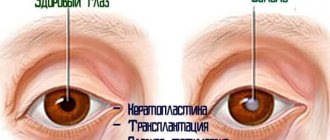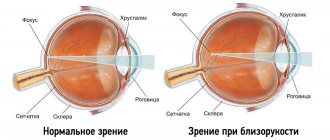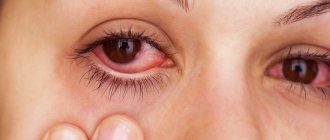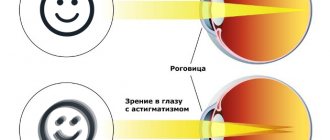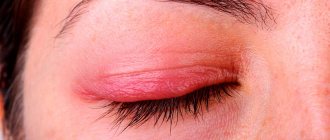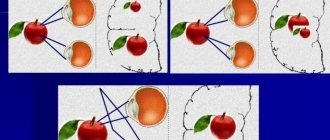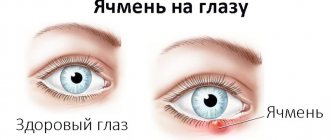Human parasites are different, some types of worms prefer to live in the intestines, a number of helminths can live under the skin, but there are also representatives that develop in the eyes.
Parasites in human eyes are extremely dangerous because they can cause metabolic disorders and tissue destruction, which leads to decreased immunity and inflammatory processes, which are accompanied by deterioration of vision. As a rule, the larvae get into both eyes, which subsequently leads to loss of vision if the person does not take any action and does not undergo treatment.
What are human parasites
Living organisms that live at the expense of another organism (i.e., a person), while causing harm to the host organism, are called human parasites. According to the medical classification, human parasites are:
- viruses;
- helminths;
- worms;
- fungi;
- arachnids;
- insects.
Human parasitoses are classified as follows:
- geohelminthosis - an infection in which the parasite first develops inside the host, and at a certain stage continues to develop on a non-living substrate;
- biohelminthiases – an infection in which a person is an intermediate or final host;
- contact helminth infections - this type of infection is characterized by the fact that the parasite is released from the host’s body already developed and is capable of infecting another person or re-infecting the host itself.
Prevention
Of course, the easiest way to prevent the disease at home is to not let the cat go outside. In other cases, this is more difficult to do. If you live in a private house, you must do your best to fight flies and prevent their appearance.
Destroy garbage and waste, arrange compost heaps as far away from the house as possible, and regularly fill cesspools with lime or ash. If you live in an area where cases of thelaziosis are regularly reported, be sure to treat your pet's skin with repellent before each walk.
Of course, plays an important role . If the fur around the eye sockets is constantly covered with dried discharge, and the eyes themselves look red and swollen, it would be a good idea to take your pet to the veterinarian. Of course, in situations where you can see the larvae yourself, you need to do this immediately.
What parasites live in human eyes
The general name of the pathology in which eye parasites in humans are diagnosed is myiasis. Infection can occur in different ways, and several types of worms live in human eyes; most often the causative agents are fly larvae. There are two types of myiases depending on location:
- intraocular – very rare, the parasite develops inside the eyeballs;
- external – represented by boils, conjunctivitis (destructive ophthalmomyasis), granulomas.
There are different types of worms that can appear in the eyes:
- fluke worm;
- echinococcus;
- lungworm;
- Diptera larvae;
- trematodes;
- dirofilaria, etc.
Heartworms and Gnathostoma
Dirofilariasis is a disease that develops due to a mosquito bite. Because of this, a parasite enters the human body and accumulates in the skin of the eyelids. It can also get into the conjunctiva, the thin tissue that covers the eyes and the back of the eyelids. If dirofilariae settle in the anterior chamber of the eye, they can create a granuloma, leading to double vision.
However, the most common symptoms observed are:
- Foreign body sensation.
- Edema.
- Secretion of tears.
- Itching.
- Peeling of the skin.
- Problems with eyelid mobility.
- The appearance of lumps under the skin.
- Pain syndrome both during palpation and at rest.
If the human body becomes infected with a parasite called Gnathostoma, then patients develop gnathostomiasis. This occurs if you eat an infected bird, snake, fish or frog. Once inside, the parasite can reach the eyes, but is unable to return to the gastrointestinal tract. In general, this interferes with the development of the worm; humans are an accidental host for it.
How do parasites migrate into the eyes?
Most often, helminths live in different parts of the intestines, lungs, liver, under the skin and throughout the human body, and enter the body in the following ways:
- due to consumption of insufficiently thermally processed food of animal origin, such as meat, fish;
- due to consumption of unwashed vegetables and fruits;
- parasite eggs are carried by flies and remain on human hands after interacting with animals;
- contact through contaminated soil.
There are cases when worms in a person’s eyes can appear not only from direct infection, but also due to migration from other organs through the blood. Migration of parasites to the eyes is as likely as to other organs. The appearance of a parasite on the eyeballs is easier to notice and treat in time than, for example, parasites of the brain. As soon as parasitosis develops in the eyes, the patient feels that something is moving in the eye, which prompts him to consult a doctor.
Tapeworms
Echinococcus
Basically, the larvae parasitize in the human intestines, but they are capable of spreading throughout the body along with the bloodstream and penetrating into other organs, including the eyes. A cyst forms at the site of infection by the larva, which grows in size over time and pushes the eyeball out. Patients complain of constant pressure in the eye area, problems with blinking and a feeling of constant dryness in the mucous membrane of the affected eye.
Sometimes the parasite migrates into the tear ducts, resulting in increased lacrimation.
Pork tapeworm
You can catch the parasite by eating contaminated food and poorly cooked meat from pigs and wild boars. In this case, a person acts as an intermediate host. Tapeworm is mainly localized in the gastrointestinal tract, but is capable of migrating throughout the body and affecting other organs.
The main feature of the disease is that it often does not manifest itself with symptoms, and then can provoke a sharp deterioration in health, including death.
Sheep Brain
The parasite enters the human body extremely rarely, but can cause serious health problems. The parasite larvae migrate to the brain area, cause necrotic tissue changes and can cause death. Sometimes the larvae also affect the organs of vision. Symptoms: redness and soreness of the eye, disruption of the integrity of the retina, glaucoma, complete loss of vision.
Trematodes
Liver flukes often get into the eyes, migrating to the biliary system, enter the bloodstream and affect the brain and eyes. Nematodes of the genus Alaria americana are sometimes found in people's eyes. The definitive host of the parasite is a dog; a person can catch the worm by eating frog legs that have not undergone sufficient heat treatment.
Eye damage may be associated with opisthorchiasis. The parasite mainly affects the digestive organs, but can migrate to the eyes, causing serious vision problems.
Symptoms of parasites in human eyes
Painful changes in the eyeballs in humans due to infection with infestations may differ depending on the type of pathogen and the location of the inflammation (on the mucous membrane or inside the eyeball). The disease, caused by a pathogen inside the eye, has less severe symptoms of worms in the eyes. In the initial stages of development of the pathogen, the patient is bothered by itching under the eyelid. The parasite, which lives inside the eyeball when it reaches maturity, causes severe symptoms:
- pain inside the eyeball due to damage to nerve tissues and their inflammation;
- movement in the eye;
- a cyst may appear, the location and size of which can be arbitrary;
- the eyelid swells, there is a burning sensation, itching;
- lacrimation, conjunctivitis.
Symptoms of parasites in human eyes are always accompanied by blurred vision and irritation of the mucous membrane. The result of untimely or improper treatment of myiasis can be blindness. Partial or complete blindness can be caused by a developed individual that has migrated from other organs to the eye, where it destroys tissue in order to be able to move. If parasites are detected late in a person’s eyes, the symptoms may be more severe:
- blindness;
- deterioration or partial loss of vision;
- retinal damage;
- corneal ulcers;
- severe allergic skin reactions.
Ocular opisthorchiasis
A disease called ocular opisthorchiasis occurs due to infection by the pathogen opisthorchiasis helminth (also known as the cat fluke). The route of infection is the consumption of raw, poorly heat-treated, helminth-infected fish. The disease begins with an acute allergic reaction. First, the pathogen affects the digestive organs and can be localized on several organs and systems. When the helminth migrates into the eye, there is a possibility of keratitis or optic neuritis and more serious consequences - blindness.
Echinococcosis of the eye
Infection with Echinococcus tapeworms is more dangerous than other infestations. The disease is characterized by an asymptomatic stage, so this disease cannot be cured quickly. The first stage is characterized by the appearance of cysts on internal organs and possible skin damage by urticaria. Severe symptoms of ocular echinococcosis appear in the second stage. Observed:
- severe pain in the conjunctiva, eyeballs and orbit;
- the appearance of cysts of different sizes on the front shell of the eye, under the eyelid.
- Cherry jam in a slow cooker
- Swelling of the legs: causes and treatment
- Expectorants for bronchitis
Dirofilariasis
Dirofilariasis infection occurs through insect bites that carry helminth eggs. In humans, the disease progresses slowly and the problem is chronic. Infection occurs through a bite, and the parasite begins to develop a few days after the bite. After six months, when the individual reaches maturity, migration and penetration into the eyeball are possible. Dirofilariasis is characterized by symptoms similar to other invasions; the difference between the pathology and others is protrusion of the eye.
Ophthalmomyasis
Infestation of the eye by fly larvae can occur due to contact of the mucous membrane with the skin of the hands infected with larvae. There are types of flies that inject liquid containing eggs on the fly, so the larvae can penetrate the mucous membrane even if all hygiene rules are observed. Ophthalmomyasis can provoke chronic conjunctivitis and lead to severe iridocyclitis. This myiasis is characterized by the presence of sharp pain in the eyes; the pathogen can provoke suppuration on the mucous membrane of the eye, and in the absence of adequate treatment causes blindness.
Symptoms
Currently, there are two main types of ophthalmomyasis: internal and external.
External ophthalmomyasis is more common. It manifests itself in the formation of a tumor that resembles a boil. Larvae that have penetrated the skin continue to develop there, leading to an inflammatory reaction. As a result, a nodule forms in the thickness of the eyelid.
The patient experiences foreign body, sometimes parasitic movements that are visible to the naked eye.
In other cases, sinuous lines may appear on the skin and tend to get larger. This is called creeping myiasis.
When the larvae of the cavitary gadfly enter the mucous membrane, larval conjunctivitis develops. This disease leads to severe discomfort, so prompt removal of all larvae from the conjunctival sac is required. Sometimes this is accompanied by the development of conjunctival larval granuloma. To remove the larvae, you need to cut the mucous membrane.
Treatment of parasites in human eyes
The vast majority of cases of infection with worms or other parasites are treated with medications. When diagnosing severe cases, when drugs do not help and the infestation becomes chronic, treatment of parasites in the human eye involves removing cysts, worms or larvae from the eyeball or eyelids. This method is also used in cases where the pathogen is on the surface of the mucous membrane or there is a risk of loss of vision. During drug treatment, the following must be prescribed:
- detoxification medications;
- antiallergic (antihistamine) drugs;
- antimicrobial sulfonamide drugs.
Antihistamines and detoxification drugs are mandatory in the content of antiparasitic therapy. In addition to destroying the pathogen, it is necessary to cleanse the body of waste products secreted by the parasite, which poison the body and cause acute allergic reactions. When the parasite is located on the surface of the eye, you can do without surgery: eye rinsing together with drug therapy can help.
More about the “pedigree” of worms
But! These “worms” are not worms. Worms are “just” larvae of the fly Thelazia californiensis. The disease they cause was first described in the 30s of the last century by doctors who began to study in detail the parasitic pathologies of California. At that time, world medicine was already well aware of wolfarthiosis, but telyasia had not yet been described. However, already at that time it was known about the existence of about a dozen flies, the larvae of which behave in a similar way. But it was the “California” theliasia that turned out to be the most common species.
Dirofilariasis
Caused by a parasite moving under the skin. Most often, only one individual lives in the human body. It enters the body with a mosquito bite, remains in this state for a month, after which it begins to move under the skin, often localizing in the area of the organs of vision.
Symptoms and treatment
A small pimple appears, and you can see it moving around the body. If the parasite dies, symptoms of intoxication occur: high fever, chills, nausea.
When a helminth gets into the eye, a nodule appears on the eyelid, touching it or exposure to light becomes very painful. The eyelids swell and turn red. However, if the worm gets into the eyeball itself, as a rule, it leads to complete blindness. Treatment requires surgery to remove helminths.
Cysticercosis
It is caused by the ingestion of pork tapeworm larvae, which are a 3-15 mm bubble filled with liquid, into the stomach. In the stomach, the larval shell dissolves, and the parasite eggs are carried throughout the body with the blood. Some eggs become attached to the brain, spinal cord and muscles.
Cysticercosis is a disease in which tapeworm eggs become embedded in the vitreous humor of the eye.
Symptoms and treatment
Symptoms of eye damage: conjunctivitis, retinitis, reactive uveitis, which subsequently leads to eye atrophy and blindness. Patients notice a decrease in visual acuity and retinal detachment.
This disease must be treated with the antiparasitic drug praziquantel. Single nodes and cysts are removed surgically.
Alternative view
The fight against helminths using dope smoke is one of the most unusual and forgotten practices of traditional medicine, recently restored by the works of Professor Ogulov. It is believed that such inhalations tend to expel larvae and adult helminths from the lungs and eyes, which is confirmed by patients who attended Dr. Ogulov’s seminars. Let's try to find out the whole truth about this practice: against which worms it is effective, how it should be carried out and whether such cleaning is generally safe for humans.
—
INDICATIONS FOR CLEANING WITH Datura
Datura smoke can only fight against those parasites and their larvae that live in the lungs and eyes of a person. Thus, the lungs are affected by the following helminths:
- roundworms (both larvae and adults);
- intestinal eels (larvae);
- Echinococcus;
- pork tapeworms (cysticerci are one of the stages of their larvae);
- schistosomes (larvae);
- hookworms (larvae);
- pulmonary flukes.
Not only helminths are localized in the eyes, but also the larvae of some flies:
- toxocara
- pork tapeworms (cysticerci);
- telesia;
- pinworms (very rarely, when eggs are accidentally introduced into the eyes);
- cavitary gadflies (larvae);
- common subcutaneous gadflies (larvae);
- southern subcutaneous gadflies (larvae);
- Wohlfarth flies (larvae).
There are other parasites that choose human lungs and eyes as their habitat, but their distribution area is limited to tropical countries, and they are not scary for residents of the northern hemisphere.
WHERE TO FIND Datura
The easiest way to buy Datura herb is in a pharmacy, but due to the high toxicity of this plant, it is rarely sold in pharmacies. Datura can also be purchased in many online stores specializing in medicinal herbs and traditional medicine.
If the patient being treated decides not to spend money on cleaning at all, Datura can be collected independently - it is a very common plant. In Russia, it grows in the Volgograd, Astrakhan, Samara and Saratov regions, as well as in many black earth areas. Most often, the plant is found in littered places, landfills, abandoned arable fields, vegetable gardens and along roads.
The plant is harvested from June to October. This should only be done with gloves. It is not advisable to store stocks of Datura for more than a year.
FIRST METHOD OF CLEANING FROM PARASITES (THE SIMPLEST)
You can remove worms in this way using either green or dried dope, but green is considered a more effective remedy, especially for inhalation treatment.
- Buy datura grass or collect it yourself.
- Light the gas on the stove and place a baking tray on it.
- Place a small handful of crushed grass on the hot spot.
- When it starts to smoke, bend over the smoke so that it reaches your eyes. Breathe actively.
- If the plant is burnt out, add more.
- Complete the procedure after mild intoxication appears (the plant is hallucinogenic).
If the worms were really in the lungs or eyes, they should come out through the mouth and tear ducts.
SECOND METHOD (MOST EFFECTIVE)
This method of cleaning from helminths is fundamentally no different from the previous one, however, it allows you to create a kind of smoke bomb from dope, which will immediately release a large amount of smoke at once. The confined space also makes the product more effective.
- Prepare an electric stove in the toilet.
- Wear clothes that can be washed immediately after treatment.
- Start frying the dope in the kitchen in a covered frying pan.
- As soon as smoke starts pouring out from under the lid, quickly move to the toilet, close the door behind you, open the lid and continue frying the herb on the electric stove.
- You can sit directly on the toilet with your head tilted over the frying pan.
After treatment, you should thoroughly ventilate your home, wash your hair (they tend to absorb odors for a long time) and wash your clothes.
THIRD METHOD (ECONOMICAL)
This option for clearing helminths is good in winter and spring, when you can’t collect dope yourself and you want to save on purchased grass.
- First you need to build a smoking pipe. To do this, a 2-liter plastic bottle is bent in half in the form of an inverted letter “L”. A hole is made at the bottom (not at the bottom, but on the side), through which the smoke will be drawn. A foil pocket 2 cm deep is placed on the neck of the bottle. The foil is pressed well against the thread so that it does not allow air to pass through. 5-6 small holes are made in it with a needle - through them the smoke will enter the bottle. Dry datura herb is poured into the foil.
- Then you should lock yourself in the toilet, seal the hood, set fire to the dope and begin to breathe it through the lower hole of the smoking pipe.
The disadvantage of this method is the low concentration of smoke in the air. It may simply not be enough to cleanse the eyes of parasites. Ideally, treatment with this method should be carried out simultaneously by two people so that they can take turns fumigating each other’s eyes. To do this, interrupt the puffs for 15 seconds so that the foil has time to cool slightly, and then forcefully blow the smoke inside, pointing the exit hole at the other person’s eyes.
CLEANSING FROM PARASITES OF OTHER ORGANS
Of all the types of worms that parasitize the human body, only the pulmonary fluke chooses the lungs as its main habitat, and it is also capable of penetrating the brain. The eyes are the only place of localization only for telesia. Therefore, cleaning the eyes is not enough, since the presence of other helminths in them always indicates that other organs are also infected with parasites:
- liver and brain with toxocariasis;
- lungs, heart, skin, spinal cord and brain in cysticercosis;
- intestines with enterobiasis.
Trying to remove helminths living in the gastrointestinal tract by making various decoctions and infusions from dope is strictly contraindicated. Datura is a very toxic drug, and only its smoke is relatively safe. As a decoction, it is used only against the growth of unwanted hair on the body and face.
If it is necessary to get rid of intestinal and liver parasites, completely different folk remedies can come to the rescue - anthelmintic tinctures, extracts and preparations for preparing a decoction. The raw materials for these products are centuries-tested anthelmintic herbs:
- birch leaves;
- peppermint;
- ferula jungarica;
- wormwood;
- swamp grass;
- tansy;
- Chinese sumac;
- yarrow;
- common agrimony;
- calendula officinalis;
- Salvia officinalis;
- pharmaceutical camomile;
- Oak bark.
In addition, the composition of the tinctures additionally includes bear bile extract - one of the few means that helps get rid of parasite eggs. This prevents self-infection of a person when infected with eels, dwarf and pork tapeworms, the eggs of which tend to develop without leaving the host’s body.
In the right doses, folk remedies against helminths have no harmful properties, no age or health restrictions. In addition, each of the anthelmintic plants has many other beneficial properties. Thus, birch leaves are an antiseptic, antispasmodic, diuretic, and treat bronchitis and pneumonia.
You can buy natural remedies against helminths only on the websites of their manufacturers, links to which you can find here.
CONCLUSION
Cleaning the eyes and lungs of parasites using a “smoke bomb” of Datura is not a pleasant procedure, but it is quite safe if you have a sense of proportion. The weak toxic properties of smoke allow a person to remove a number of parasites without harming his health. However, it will not be possible to get rid of intestinal and liver helminths with the help of Datura - only decoctions and tinctures from anthelmintic plants can remove these parasites within the framework of traditional medicine.
